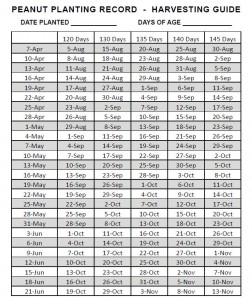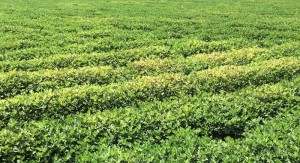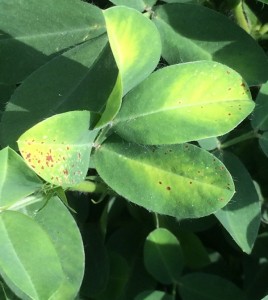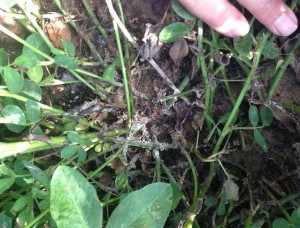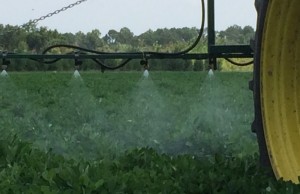Peanut Update
Most growers have peanuts that are around 100 days after planting. This is the time to start checking for maturity and determine how many days are left until digging.
For sampling peanuts, carefully lift at least 5 plants from a minimum of three representative areas in a field. Dig in the area where the plants where lifted and check for any peanuts that come off. If you findsome older mature pods in the soil bring these with the sample. The projected digging date is only as accurateas the sample used to represent the field. If a field has two soil types it needs to be split and sampled as two fields, and irrigated fields need to be sampled separately from the dry corners. Each sample should represent probably no more than 25 acres, so large fields may need to be split into 25 acre sections with a sample for each section. Each field should be sampled at approximately 105 to 110 days after planting. A second sample should be ran approximately10 days before the date predicted by the first check to determine if the peanuts are maturing normally. This process has proven to be an effective and reliable method to project up to two weeks in advancethe optimum digging date for peanuts.

Remember if you are collecting peanuts for a sample to get a good representative sample of the field, plants from several spots, but no bottoms or diseased or skippy areas. We need about 200 nuts per sample, and all the nuts need to be pulled from the vines except the tiny ones.
If you have a smart phone, the “Days between Dates” App is a good way to check the age of peanuts on your smart phone when you have the planting dates.
UGA Peanut Agronomist, Dr. Scott Monfort recommends peanut growers evaluate all of their fields that are 90 days after planting (DAP) or older. We are seeing a large variation of peanuts on the vine. Several fields have shut down around 105 DAP and are now coming loose in the hull. If the growers are not checking them until 135 DAP or more, they may indeed loose what little crop they have.
Earlier on in August we started seeing spider mite populations building. In a lot of cases these were fields that applied an insecticide that killed off beneficial insects and the mite population exploded. High heat and dry weather also makes the mites worse. They are mostly seen in dryland fields.
Here are some good comments by Dr. Mark Abney, UGA Entomologist. “The two spotted spider mite is a challenging pest to control. It thrives in hot, dry conditions where it completes development in as little as 7 days at 81ºF. Female mites can lay up to 100 eggs over several weeks, so it is easy to see how infestations can go from light to heavy in a very short period of time.
In the early stages of infestations mites will be found mostly on the undersides of leaves. Their position on the plant and the webbing they create make getting good contact with a miticide difficult. Once infestations progress, mites will be seen on lower and upper portions of the leaves. It is very common to see “hotspots” in peanut fields when infestations are just getting started. Mites will radiate out from these areas to infest the rest of the field. Populations often get established along field borders and especially borders adjacent to dirt roads or field paths.
Georgia growers are strongly urged to scout fields for spider mites as early detection can improve the odds of effective control. The ovicidal activity of miticides labeled for use in peanut is limited, so more than one application may be needed to clean up infestations. Propargite (e.g. Comite) is currently the only real option for mite control in peanut. I do not recommend the use of a pyrethroid for two spotted spider mite in peanut.”
Potato leaf hoppers were worse this year than I’ve ever seen in some fields. Unfortunately, we don’t have a threshold for treating. There have been fields with visible damage in the past that still yielded well. We cannot determine what the yield loss, if any, is with potato leaf hoppers. Therefore, it’s ultimately a decision the grower has to make on treating or not. Leaf hoppers are easy to kill with most insecticides. However, if spider mites are present in a field it’s not worth putting out a broad spectrum insecticide and making the mites worse.

Current Disease Situation from Dr. Bob Kemerait:
Conditions remain very warm; however increased rain has moved into our peanut production region over the past week and it looks like this trend will continue for the near future. Conditions now are favorable for increased development of leaf spot, white mold and other diseases. However, most growers are within weeks, to a little more than a month away from harvest. It is unlikely that diseases will have time to develop and affect yields in fields where diseases are currently well managed.
Below are some typical situations that peanut growers may find themselves in and suggestions for control.
1. Grower is four or more weeks away from harvest and currently has excellent disease control.
a. Suggestion: I recommend that the grower apply at least one more fungicide at least for leaf spot control.
b. Suggestion: Given the low cost of tebucoazole, the grower may consider applying a tan-mix of tebuconazole (7.2 fl oz) + chlorothalonil (1.0 pt/A) for added insurance of white mold and leaf spot. NOTE: If white mold is not an issue, then the grower should stick with a leaf spot spray only.
2. Grower is four or more weeks away from harvest and has disease problems in the field.
a. If the problem is with leaf spot: Grower should insure that any fungicide applied has systemic/curative activity. If a grower wants to use chlorothalonil, then suggest that they mix a product like thiophanate methyl (Topsin M), cyproconazole (Alto), propiconazole (Tilt, Bumper) with the chlorothalonil. Other growers may consider applying Headline.
b. If the problem is white mold: Grower should continue with fungicide applications for management of white mold. If they have completed their regular white mold program, then they should extend the program, perhaps with a tebuconazole/chlorothalonil mix. If the grower is unhappy with the level of control from their fungicide program, then we can offer alternative fungicides to apply.
c. If the problem is underground white mold: Underground white mold is difficult to control. Applying a white mold fungicide ahead of irrigation or rain, or applying at night, can help to increase management of this disease.
3. Grower is three or less weeks away from projected harvest and does not currently have a disease issue. Good news! This grower should be good-to-go for the remainder of the season and no more fungicides are required.
4. Grower is three or less weeks away from harvest and has a problem with disease.
a. If leaf spot is a problem and 2-3 weeks away from harvest, a last leaf spot fungicide application may be beneficial. If leaf spot is too severe, then a last application will not help.
b. If white mold is a problem and harvest is 3 weeks away, then it is likely beneficial to apply a final white mold fungicide. If harvest is 2 weeks or less away, then it is unlikely that a fungicide will be of any benefit.
c. NOTE: If harvest is likely to be delayed by threat from a hurricane or tropical storm, then the grower may reconsider recommendations for end-of-season fungicide applications.
